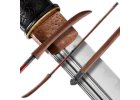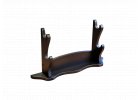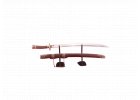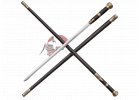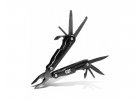Wakizashi with a groove (bo-hi) is a shorter Japanese sword, traditionally used by samurai as a supplement to the katana. The Wakizashi, like the katana, can be fitted with a bo-hi groove, which performs similar functions to those of longer swords. The bo-hi on the wakizashi helps to reduce the weight of the blade, improving maneuverability and speed in combat.
#ShowMore#
The lighter bo-hi blade makes the sword more agile and allows for faster and more accurate attacks. This feature is especially important in wakizashi, as this sword was often used for fighting in confined spaces or as a backup weapon when speed and agility played a key role. In addition to its practical function, the bo-hi also has an aesthetic and acoustic 'Tachi-Kaze' effect that animates every movement. When the wakizashi cuts through the air, the trough produces a characteristic swishing sound that is often seen as a sign of a properly executed chop. This sound is also used in training to assess technique. The wakizashi with a bo-hi groove is an ideal choice for warriors looking for a lightweight and responsive sword with excellent maneuverability without sacrificing the strength and power of the blade. Its nimble nature makes it an effective weapon in both fast-paced encounters and traditional martial arts where technical precision is required.
Comparing bo-hi (groove) versus no bo-hi (no groove) on the wakizashi offers different advantages depending on preference and use. Below are the main differences and advantages of the two options:
Wakizashi with bo-hi (gutter)
- Weight reduction: The bo-hi groove lightens the blade, making the sword lighter and easier to handle.
- Faster maneuvering: The lower weight allows for faster and more nimble movements, making it ideal for technical and fast-paced duels.
- Acoustic feedback: Bo-hi produces a swishing sound when slashing, which can be used in training as feedback to check technique.
- Better balance: Reducing the weight at a certain point of the blade can improve the balance of the sword, making it easier to control and manipulate.
- Aesthetic element: Bo-hi gives the sword a specific look that is considered aesthetically appealing and has roots in traditional Japanese sword culture.
Wakizashi without the bo-hi (without the groove)
- Greater strength: A sword without a bo-hi has a full blade, giving it greater strength and durability when struck. It is more resistant to difficult tasks such as cutting through hard materials.
- Stronger Strikes: Due to its greater weight, the bo-hiless blade provides stronger and more vigorous strikes. This can be useful when slashing against tougher targets.
- More traditional design: Some warriors prefer the bo-hiless wakizashi because of its more traditional, sturdy design that is reminiscent of the original fighting swords.
- Quiet slash: Without the bo-hi, the blade does not make as loud a swishing sound when slashing, which can be an advantage in combat situations where a quiet and stealthy attack is needed.
Summary: Bo-hi vs. no bo-hi
- With bo-hi: Ideal for faster, more nimble technicians and fighters who prefer a lighter, easier to handle sword with acoustic feedback during training.
- Without bo-hi: More suitable for those who prefer a stronger, more stable sword with more weight and punching power, suitable for hard chopping and fighting in tough conditions.
The choice between the two depends on whether you prefer lightness and speed (bo-hi) or solidity and punching power (no bo-hi).

_-_edited.png)




